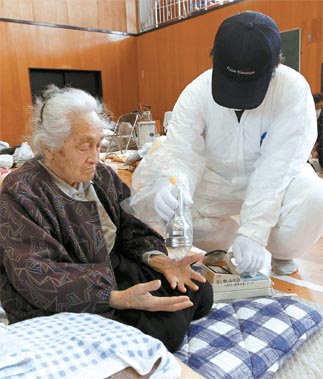Signs of Japan nuclear crisis easing

An official in a radiation suit scans an elderly woman with a Geiger counter yesterday at a shelter in Koriyama, Fukushima Prefecture, 60 kilometers (37 miles) west of the Fukushima nuclear power plant. [AFP/YONHAP]
The Fukushima Daiichi power station’s No. 3 reactor experienced a rise in pressure yesterday, but Japanese authorities said later in the day that the reactor appeared to be stabilizing.
“I think the situation [at the plant] is improving step by step,” Deputy Chief Cabinet Secretary Tetsuro Fukuyama said at a news conference yesterday as 300 engineers battled to contain the situation at the six-reactor Fukushima plant.
The No. 3 reactor, which contains highly toxic plutonium, stabilized after fire trucks doused it for hours with hundreds of tons of water. “We believe the water is having a cooling effect,” said an official from plant operator Tokyo Electric Power Co. (Tepco).
Work also advanced to bring power back to water pumps used to cool overheating nuclear fuel, and temperatures in pools containing the spent fuel rods in reactors No. 5 and 6 were returning to normal. Technicians attached a power cable to reactor Nos. 1, 2, 5 and 6, hoping to restore electricity later in the day, prior to attempting to switch the pumps on. They aim to reach No. 4 today or Tuesday.
If successful, the moves could be a turning point in a crisis rated worse than the United States’ Three Mile Island nuclear accident in 1979. If not, drastic measures such as burying the plant in sand and concrete, as officials did in Chernobyl in 1986, may be required. But experts warn that could take many months. Facing criticism for how it has handled the situation, Tepco’s president issued a public apology for “causing such great concern and nuisance.”
Even after restoring power, the company faces the tricky task of reactivating the cooling pumps, with parts of the system probably damaged from the 9.0-magnitude earthquake or subsequent explosions.
Meanwhile, traces of radioactivity exceeding national safety standards were found in spinach grown in the neighboring Ibaraki prefecture and in milk from a farm about 30 kilometers (18 miles) from the plant. But Japanese officials say levels so far are not alarming. Due in part to concerns about exposure to radiation, the Korean government on Saturday pulled all members of its 107-member search-and-rescue team in Japan out of Sendai, near Fukushima, to the western coastal city of Niigata.
The Fukushima nuclear crisis was the centerpiece of the agenda discussed when the foreign ministers from Korea, Japan and China gathered in Kyoto on Saturday. During the meeting, Korean Minister of Foreign Affairs and Trade Kim Sung-hwan agreed with his Japanese and Chinese counterparts to strengthen trilateral cooperation regarding nuclear safety.
According to the Foreign Ministry, Kim agreed with Japanese Foreign Minister Takeaki Matsumoto and Chinese Foreign Minister Yang Jiechi to work closely together in disaster management and nuclear safety. The two items will be discussed more thoroughly during an upcoming Korea-Japan-China summit slated for later this year in Japan, Seoul officials said.
Another Korean was confirmed dead yesterday, raising the number of Korean nationals confirmed killed during the quake and tsunami to two so far. According to the Foreign Ministry, the body of a 37-year-old Korean woman surnamed Jeon was confirmed by Korean officials to be at a gymnasium in Ishinomaki, a city in Miyagi Prefecture, yesterday. As of yesterday, 41 other Koreans remained unaccounted for.
According to Japanese police, the number of people killed or still missing surpassed 20,000 yesterday.
By Moon Gwang-lip, Reuters [joe@joongang.co.kr]
Related Korean Article[연합]
원전 전력복구…고비 넘겼나
냉각수순환ㆍ밸브자동개폐ㆍ압력조절ㆍ모니터링 가능
일본 후쿠시마(福島) 원전 사고가 `수습`과 `대참사` 사이에서 중요한 전기(轉機)를 맞고 있다.
알려진대로 조만간 전력선 복구와 함께 전력이 공급되기 시작하면 냉각수 순환과 압력 조절 관련 장치들이 다시 가동하면서 사태를 빠르게 안정시킬 수 있기 때문이다.
일본 원자력안전보안원은 18일 기자회견에서 "오늘 안으로 1ㆍ2ㆍ5ㆍ6호기, 내일(20일) 중으로 3ㆍ4호기 전력이 복구될 예정"이라고 밝혔다.
전문가들 사이에서는 지금 현재 원전 상태에서는 전력 복구가 사태를 안정시킬 수 있는 거의 유일한 해결 방법이라는데 이의가 없다.
전력 공급이 중요한 것은 이번 후쿠시마 원전 사태의 근본 원인이 지진에 따른 비상 디젤발전기 고장으로 원전의 냉각 시스템이 망가진 데 있기 때문이다. 냉각수 공급이 제대로 되지 않자 원자로 안의 핵연료봉, 사용후 핵연료봉 등에서 모두 남은 열(殘熱)이 살아나 노심 용해(원자로가 녹는 현상)가 실제로 일부 일어났고, 재임계(핵분열) 가능성까지 거론된 것이다.
이제 전원이 들어오면 전기 펌프가 돌아가면서 냉각수의 단순한 `공급`이 아니라 `순환`이 가능해진다. 자동으로 찬 바닷물을 달궈진 원자로 내부(핵연료봉)나 사용후핵연료 보관 수조에 집어넣고, 그 안에서 데워져 나오는 물을 다시 식혀 집어넣는 과정이 자동으로 이뤄진다는 얘기다.
지금까지 작업자들의 피폭을 감수하고 필사적으로 진행된 헬리콥터ㆍ살수차를 동원한 냉각수 공급 작업이 필요 없어질 뿐 아니라 지금처럼 물을 쏟아부어도 금세 증발하고 없어지는 게 아니라 한 번 들어간 물이 순환하며 유지되기 때문에 냉각 효율과 속도가 비교할 수 없을 정도로 개선된다.
또 냉각수 및 압력조절 관련 각종 밸브의 자동 개폐가 가능해지면서 상황을 판단해가며 원자로의 냉각ㆍ압력 수준을 원격 관리할 수 있게 된다. 작업자들이 원자로가 방출하는 엄청난 방사선을 맞으면서 힘겹게 밸브를 수동으로 여닫을 필요도 없다.
수증기와 가스형태의 방사성 물질로 가득차 있는 원자로 내부의 압력 조절도 쉬워진다. 1ㆍ3ㆍ4호기에서는 `서프레션 풀`과 같은 압력 배출 장치가 다시 제 역할을 할 수 있고, 원자로 내부에 설치돼있는 스프레이 장치(원자로 내부 증기에 물을 뿌려 증기량을 줄이는 장치)까지 돌아가면 증기 압력에 따른 원자로 폭발을 걱정하지 않아도 된다.
더구나 전기 공급과 함께 각종 원자로내 계측 장비들이 돌아가면, 보다 정확하게 현재 원자로의 상황과 문제를 파악할 수 있다.
다만 현재 배관과 밸브 상태가 관건이다. 배관과 밸브가 여러 폭발이나 바닷물 공급 과정에서 망가져 있다면, 전력이 공급돼도 무용지물이기 때문이다.
정용훈 KAIST 원자력및양자공학과 교수는 "파이프 라인이나 배관이 한 두개가 아니기 때문에 손상이 있었다해도 모든 라인과 배관이 고장났을 가능성은 낮다"며 "전력이 공급되면 상황이 좋아질 것으로 기대한다"고 말했다.
윤철호 한국원자력안전기술원장은 "살수차 등을 통해 밖에서 물을 부어 식히는데는 한계가 있는 만큼 전기 공급과 함께 내부에 직접 물을 공급하는 게 중요하다"며 "전력공급 이후 효과를 기다리며 지켜봐야 할 시점"이라고 진단했다.










with the Korea JoongAng Daily
To write comments, please log in to one of the accounts.
Standards Board Policy (0/250자)